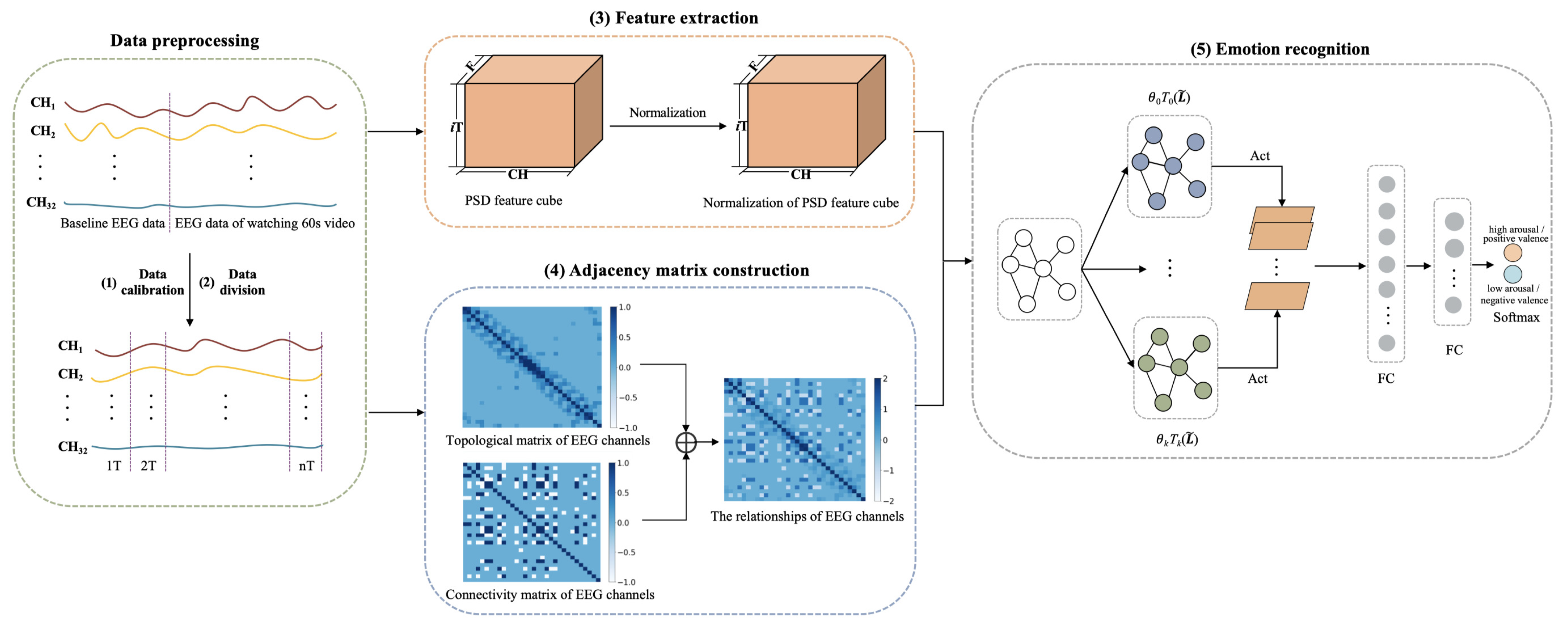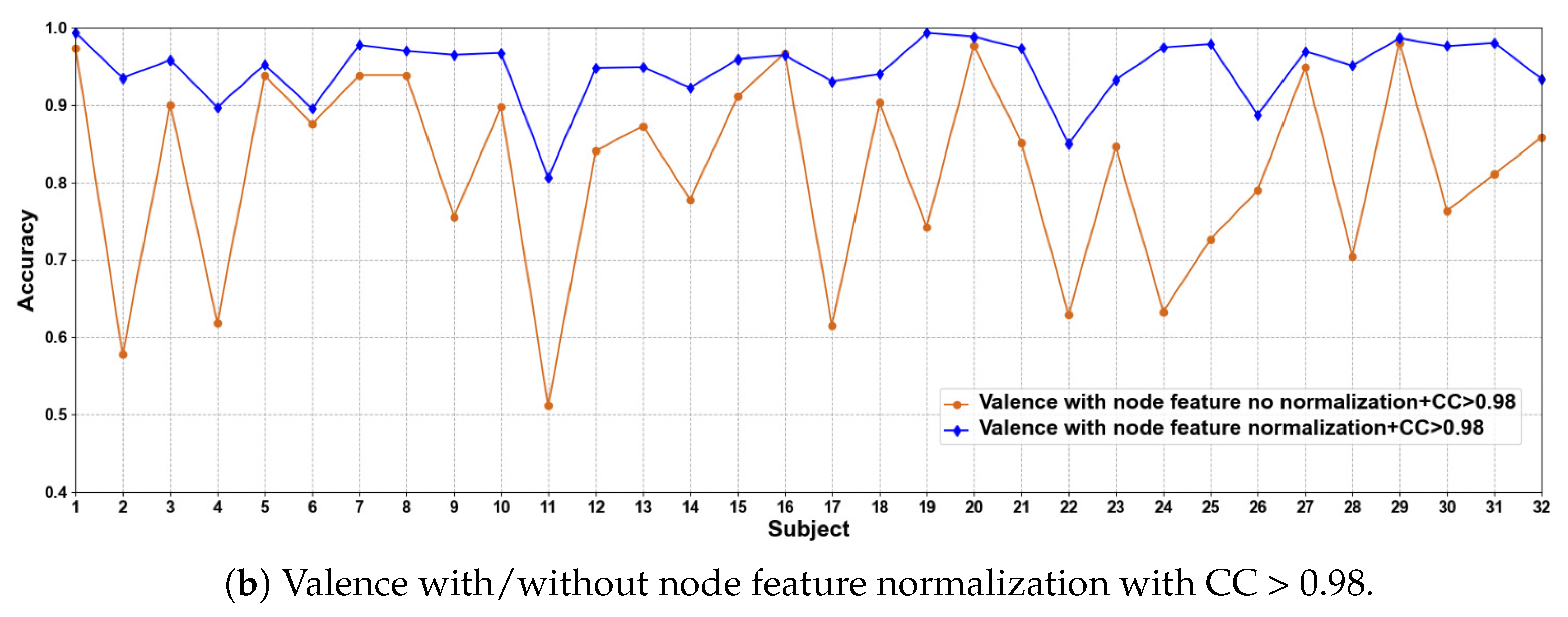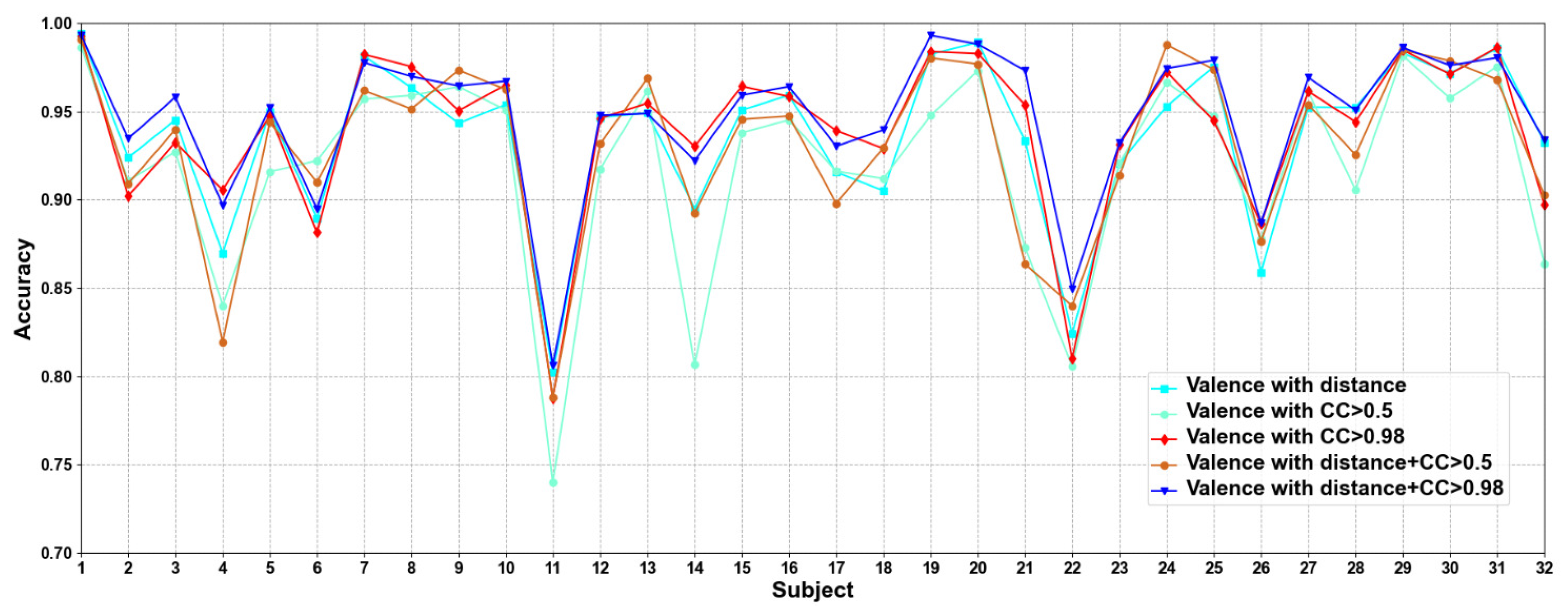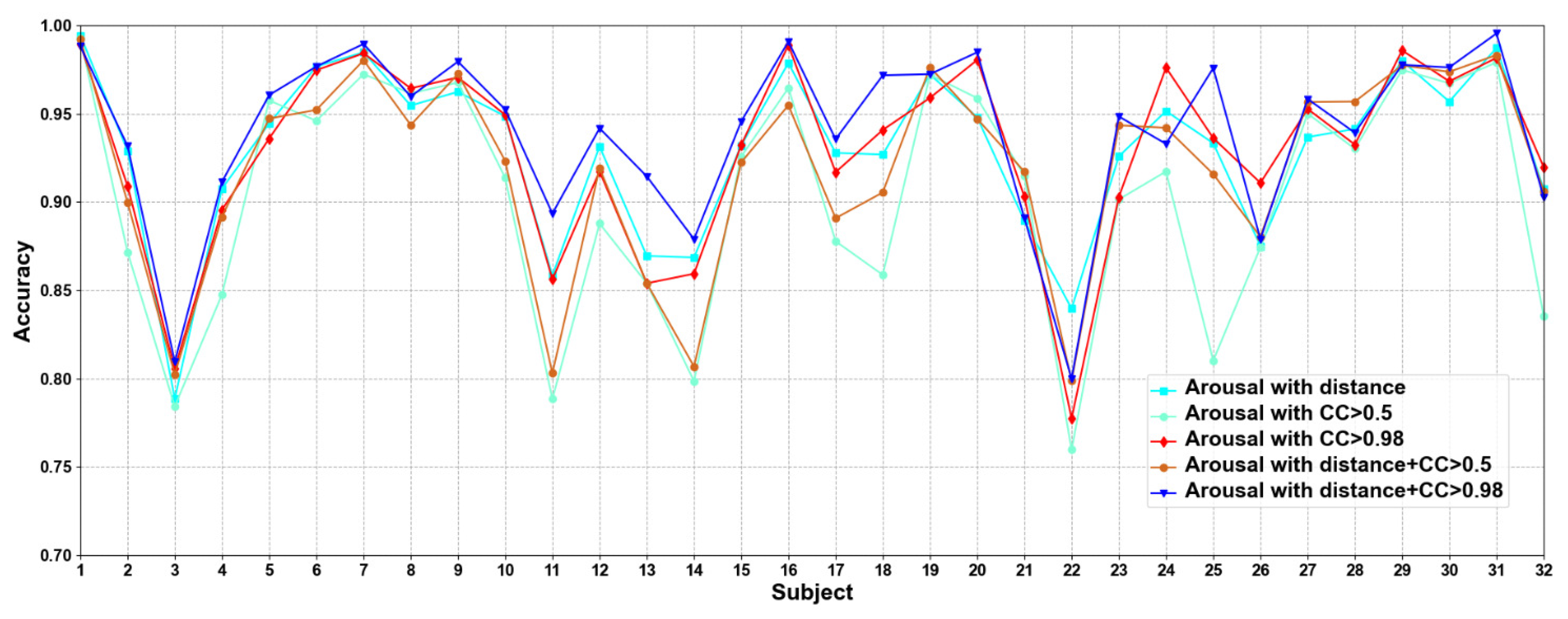CR-GCN: Channel-Relationships-Based Graph Convolutional Network for EEG Emotion Recognition
Abstract
:1. Introduction
- A novel emotion recognition method by exploiting multiple relationships among EEG channels is proposed. The topological structure of EEG channels represents local relationships, and the brain functional connectivity represents global relationships. Our method combines both relationships, which captures both local and global relationships among EEG channels, and can more accurately reflect the interaction between EEG signals.
- A fusion method for relationships among EEG channels is proposed. Graph is used to represent the topological relationship and functional connectivity relationship of EEG channels. EEG channel relationships are constructed by an adjacency matrix in GCN. The adjacency matrix is constructed from the corresponding adjacency matrices represented by two graphs.
- Experimental results demonstrate that the CR-GCN method achieves better classification results than the state-of-the-art methods.
2. Related Work
2.1. Features of EEG Signals
2.2. Graph Convolutional Network
3. CR-GCN Method
3.1. Feature Extraction
3.2. Design of Channel Relationships Based GCN
3.2.1. Graph Representation
3.2.2. Spectral Graph Filtering
3.3. Algorithm of CR-GCN
| Algorithm 1: The algorithm of CR-GCN |
| Input: EEG features, class labels, the number of Chebyshev polynomial K, the number of iterations , learning rate , stop iteration threshold e; Ouput: The desired parameters of CR-GCN;
|
4. Experiments
4.1. Dataset
4.2. Evaluation Metrics and Model Settings
4.3. Results
4.3.1. Subject-Dependent Experiments
4.3.2. Subject-Independent Experiments
4.3.3. Ablation Experiments
5. Conclusions
- The design of adjacency matrix captures local and global relationships among EEG channels and describes the relationships among EEG channels more accurately. The adjacency matrix design not only considers the biological topology but also considers the functional connectivity among EEG channels. Therefore, CR-GCN describes the relationships among EEG channels more accurately than ERDL [18];
- The graph representation of CR-GCN provides a better method to capture interchannel relationships and extract graph domain features, which is beneficial to realize emotion recognition.
Author Contributions
Funding
Institutional Review Board Statement
Informed Consent Statement
Data Availability Statement
Acknowledgments
Conflicts of Interest
References
- Cowie, R.; Douglas-Cowie, E.; Tsapatsoulis, N.; Votsis, G.; Kollias, S.; Fellenz, W.; Taylor, J.G. Emotion recognition in human-computer interaction. IEEE Signal Process. Mag. 2001, 18, 32–80. [Google Scholar] [CrossRef]
- Wang, Z.; Tong, Y.; Heng, X. Phase-locking value based graph convolutional neural networks for emotion recognition. IEEE Access 2019, 7, 93711–93722. [Google Scholar] [CrossRef]
- Álvarez-Pato, V.M.; Sánchez, C.N.; Domínguez-Soberanes, J.; Méndoza-Pérez, D.E.; Velázquez, R. A Multisensor Data Fusion Approach for Predicting Consumer Acceptance of Food Products. Foods 2020, 9, 774. [Google Scholar] [CrossRef] [PubMed]
- Álvarez, V.M.; Sánchez, C.N.; Gutiérrez, S.; Domínguez-Soberanes, J.; Velázquez, R. Facial emotion recognition: A comparison of different landmark-based classifiers. In Proceedings of the 2018 International Conference on Research in Intelligent and Computing in Engineering (RICE), San Salvador, El Salvador, 22–24 August 2018; pp. 1–4. [Google Scholar]
- Guo, J.; Lei, Z.; Wan, J.; Avots, E.; Hajarolasvadi, N.; Knyazev, B.; Anbarjafari, G. Dominant and complementary emotion recognition from still images of faces. IEEE Access 2018, 6, 26391–26403. [Google Scholar] [CrossRef]
- West, M.J.; Copland, D.A.; Arnott, W.L.; Nelson, N.L.; Angwin, A.J. Effects of prosodic and semantic cues on facial emotion recognition in relation to autism-like traits. J. Autism Dev. Disord. 2018, 48, 2611–2618. [Google Scholar] [CrossRef] [PubMed]
- Petrantonakis, P.C.; Hadjileontiadis, L.J. A novel emotion elicitation index using frontal brain asymmetry for enhanced EEG-based emotion recognition. IEEE Trans. Inf. Technol. Biomed. 2011, 15, 737–746. [Google Scholar] [CrossRef] [PubMed]
- Zhou, S.; Huang, D.; Liu, C.; Jiang, D. Objectivity meets subjectivity: A subjective and objective feature fused neural network for emotion recognition. Appl. Soft Comput. 2022, 122, 108889. [Google Scholar] [CrossRef]
- Zhang, Y.; Cheng, C.; Wang, S.; Xia, T. Emotion recognition using heterogeneous convolutional neural networks combined with multimodal factorized bilinear pooling. Biomed. Signal Process. Control. 2022, 77, 103877. [Google Scholar] [CrossRef]
- Alarcao, S.M.; Fonseca, M.J. Emotions recognition using EEG signals: A survey. IEEE Trans. Affect. Comput. 2017, 10, 374–393. [Google Scholar] [CrossRef]
- Guo, J.Y.; Cai, Q.; An, J.P.; Chen, P.Y.; Ma, C.; Wan, J.H.; Gao, Z.K. A Transformer based neural network for emotion recognition and visualizations of crucial EEG channels. Phys. A Stat. Mech. Its Appl. 2022, 603, 127700. [Google Scholar] [CrossRef]
- Acharya, U.R.; Sudarshan, V.K.; Adeli, H.; Santhosh, J.; Koh, J.E.; Adeli, A. Computer-aided diagnosis of depression using EEG signals. Eur. Neurol. 2015, 73, 329–336. [Google Scholar] [CrossRef]
- Zheng, W.; Tang, H.; Huang, T.S.; Konar, A.; Charkraborty, A. Emotion recognition from non-frontal facial images. Pattern Anal. Approach 2014, 1, 183–213. [Google Scholar]
- Ekman, P.; Keltner, D. Universal facial expressions of emotion. Nonverbal Commun. Where Nat. Meets Cult. 1997, 27, 46. [Google Scholar]
- Zheng, W.L.; Lu, B.L. Investigating critical frequency bands and channels for EEG-based emotion recognition with deep neural networks. IEEE Trans. Auton. Ment. Dev. 2015, 7, 162–175. [Google Scholar] [CrossRef]
- Tripathi, S.; Acharya, S.; Sharma, R.D.; Mittal, S.; Bhattacharya, S. Using deep and convolutional neural networks for accurate emotion classification on deap dataset. In Proceedings of the 29th IAAI Conference, San Francisco, CA, USA, 4–9 February 2017. [Google Scholar]
- Zhong, P.; Wang, D.; Miao, C. EEG-Based Emotion Recognition Using Regularized Graph Neural Networks. IEEE Trans. Affect. Comput. 2020, accepted. [Google Scholar] [CrossRef]
- Yin, Y.; Zheng, X.; Hu, B.; Zhang, Y.; Cui, X. EEG emotion recognition using fusion model of graph convolutional neural networks and LSTM. Appl. Soft Comput. 2021, 100, 106954. [Google Scholar] [CrossRef]
- Kober, H.; Barrett, F.; Joseph, J.; Bliss-moreau, E.; Lindquist, K.; Wager, T.D. Functional grouping and cortical—Subcortical interactions in emotion: A meta-analysis of neuroimaging studies. Neuroimage 2008, 42, 998–1031. [Google Scholar] [CrossRef] [Green Version]
- Kim, M.J.; Loucks, R.A.; Palmer, A.L.; Brown, A.C.; Solomon, K.M.; Marchante, A.N.; Whalen, P.J. The structural and functional connectivity of the amygdala: From normal emotion to pathological anxiety. Behav. Brain Res. 2011, 223, 403–410. [Google Scholar] [CrossRef] [Green Version]
- Musha, T.; Terasaki, Y.; Haque, H.A.; Ivamitsky, G.A. Feature extraction from EEGs associated with emotions. Artif. Life Robot. 1997, 1, 15–19. [Google Scholar] [CrossRef]
- Aftanas, L.I.; Reva, N.V.; Varlamov, A.A.; Pavlov, S.V.; Makhnev, V.P. Analysis of evoked EEG synchronization and desynchronization in conditions of emotional activation in humans: Temporal and topographic characteristics. Neurosci. Behav. Physiol. 2004, 34, 859–867. [Google Scholar] [CrossRef]
- Urigüen, J.A.; Garcia-Zapirain, B. EEG artifact removal—state-of-the-art and guidelines. J. Neural Eng. 2015, 12, 031001. [Google Scholar] [CrossRef]
- Hjorth, B. EEG analysis based on time domain properties. Electroencephalogr. Clin. Neurophysiol. 1970, 29, 306–310. [Google Scholar] [CrossRef]
- Petrantonakis, P.C.; Hadjileontiadis, L.J. Emotion recognition from EEG using higher order crossings. IEEE Trans. Inf. Technol. Biomed. 2009, 14, 186–197. [Google Scholar] [CrossRef] [PubMed]
- Liu, Y.; Sourina, O. Real-Time Fractal-Based Valence Level Recognition from EEG. Trans. Comput. Sci. XVIII 2013, 7848, 101–120. [Google Scholar]
- Sh, L.; Jiao, Y.; Lu, B. Differential entropy feature for EEG-based vigilance estimation. In Proceedings of the 2013 35th Annual International Conference of the IEEE Engineering in Medicine and Biology Society (EMBC), Osaka, Japan, 3–7 July 2013; pp. 6627–6630. [Google Scholar]
- Zheng, W.L.; Liu, W.; Lu, Y.; Lu, B.L.; Cichocki, A. Emotionmeter: A multimodal framework for recognizing human emotions. IEEE Trans. Cybern. 2018, 49, 1110–1122. [Google Scholar] [CrossRef] [PubMed]
- Lin, O.; Liu, G.Y.; Yang, J.M.; Du, Y.Z. Neurophysiological markers of identifying regret by 64 channels EEG signal. In Proceedings of the 12th International Computer Conference on Wavelet Active Media Technology and Information Processing (ICCWAMTIP), Chengdu, China, 18–20 December 2015; pp. 395–399. [Google Scholar]
- Shi, Y.; Zheng, X.; Li, T. Unconscious emotion recognition based on multi-scale sample entropy. In Proceedings of the IEEE International Conference on Bioinformatics and Biomedicine, Madrid, Spain, 3–6 December 2018; pp. 1221–1226. [Google Scholar]
- Jenke, R.; Peer, A.; Buss, M. Feature extraction and selection for emotion recognition from EEG. IEEE Trans. Affect. Comput. 2014, 5, 327–339. [Google Scholar] [CrossRef]
- Lin, Y.P.; Wang, C.H.; Jung, T.P.; Wu, T.L.; Jeng, S.K.; Duann, J.R.; Chen, J.H. EEG-based emotion recognition in music listening. IEEE Trans. Biomed. Eng. 2010, 57, 1798–1806. [Google Scholar] [PubMed]
- Sbargoud, F.; Djeha, M.; Guiatni, M.; Ababou, N. WPT-ANN and Belief Theory Based EEG/EMG Data Fusion for Movement Identification. Trait. Signal 2019, 36, 383–391. [Google Scholar] [CrossRef]
- Song, T.; Zheng, W.; Song, P.; Cui, Z. EEG Emotion Recognition Using Dynamical Graph Convolutional Neural Networks. IEEE Trans. Affect. Comput. 2020, 11, 532–541. [Google Scholar] [CrossRef] [Green Version]
- Zheng, F.; Hu, B.; Zhang, S.; Li, Y.; Zheng, X. EEG Emotion Recognition based on Hierarchy Graph Convolution Network. In Proceedings of the IEEE International Conference on Bioinformatics and Biomedicine (BIBM), Houston, TX, USA, 9–12 December 2021; pp. 1628–1632. [Google Scholar]
- Chao, H.; Dong, L.; Liu, Y.; Lu, B. Emotion recognition from multiband EEG signals using CapsNet. Sensors 2019, 19, 2212. [Google Scholar] [CrossRef] [Green Version]
- Defferrard, M.; Bresson, X.; Vandergheynst, P. Convolutional neural networks on graphs with fast localized spectral filtering. In Proceedings of the Advances in Neural Information Processing Systems, Barcelona, Spain, 5–10 December 2016. [Google Scholar]
- Such, F.P.; Sah, S.; Dominguez, M.A.; Pillai, S.; Zhang, C.; Michael, A.; Ptucha, R. Robust spatial filtering with graph convolutional neural networks. IEEE J. Sel. Top. Signal Process. 2017, 11, 884–896. [Google Scholar] [CrossRef] [Green Version]
- Jin, M.; Chen, H.; Li, Z.; Li, J. EEG-based Emotion Recognition Using Graph Convolutional Network with Learnable Electrode Relations. In Proceedings of the 2021 43rd Annual International Conference of the IEEE Engineering in Medicine and Biology Society (EMBC), Virtual Event, 1–5 November 2021; pp. 5953–5957. [Google Scholar]
- Zheng, X.; Yu, X.; Yin, Y.; Li, T.; Yan, X. Three-dimensional feature maps and convolutional neural network-based emotion recognition. Int. J. Intell. Syst. 2021, 36, 6312–6336. [Google Scholar] [CrossRef]
- Ou, Y.; Xue, Y.; Yuan, Y.; Xu, T.; Pisztora, V.; Li, J.; Huang, X. Semi-supervised cervical dysplasia classification with learnable graph convolutional network. In Proceedings of the 2020 IEEE 17th International Symposium on Biomedical Imaging (ISBI), Iowa City, IA, USA, 4–7 April 2020; pp. 1720–1724. [Google Scholar]
- De Munck, J.; Vijn, P.; Lopes da Silva, F. A random dipole model for spontaneous brain activity. IEEE Trans. Biomed. Eng. 1992, 39, 791–804. [Google Scholar] [CrossRef]
- Salvador, R.; Suckling, J.; Coleman, M.R.; Pickard, J.D.; Menon, D.; Bullmore, E.D. Neurophysiological architecture of functional magnetic resonance images of human brain. Cereb. Cortex 2005, 15, 1332–1342. [Google Scholar] [CrossRef] [Green Version]
- Achard, S.; Bullmore, E. Efficiency and cost of economical brain functional networks. PLoS Comput. Biol. 2007, 3, e17. [Google Scholar] [CrossRef]
- Jang, S.; Moon, S.E.; Lee, J.S. EEG-based video identification using graph signal modeling and graph convolutional neural network. In Proceedings of the IEEE International Conference on Acoustics, Speech and Signal Processing, Calgary, AB, Canada, 15–20 April 2018; pp. 3066–3070. [Google Scholar]
- Koelstra, S.; Muhl, C.; Soleymani, M.; Lee, J.S.; Yazdani, A.; Ebrahimi, T.; Pun, T.; Nijholt, A.; Patras, I. Deap: A database for emotion analysis using physiological signals. IEEE Trans. Affect. Comput. 2011, 3, 18–31. [Google Scholar] [CrossRef] [Green Version]
- Yang, Y.; Wu, Q.; Qiu, M.; Wang, Y.; Chen, X. Emotion recognition from multi-channel EEG through parallel convolutional recurrent neural network. In Proceedings of the International Joint Conference on Neural Networks, Rio de Janeiro, Brazil, 8–13 July 2018; pp. 1–7. [Google Scholar]
- Chen, J.X.; Zhang, P.W.; Mao, Z.J.; Huang, Y.F.; Jiang, D.M.; Zhang, Y.N. Accurate EEG-based emotion recognition on combined features using deep convolutional neural networks. IEEE Access 2019, 7, 44317–44328. [Google Scholar] [CrossRef]
- Ma, J.; Tang, H.; Zheng, W.L.; Lu, B.L. Emotion Recognition using Multimodal Residual LSTM Network. In Proceedings of the 27th ACM International Conference on Multimedia, Nice, France, 21–25 October 2019; pp. 176–183. [Google Scholar]
- Qiu, J.L.; Li, X.Y.; Hu, K. Correlated attention networks for multimodal emotion recognition. In Proceedings of the 2018 IEEE International Conference on Bioinformatics and Biomedicine (BIBM), Barcelona, Spain, 4–8 May 2018; pp. 2656–2660. [Google Scholar]
- Xing, X.; Li, Z.; Xu, T.; Shu, L.; Hu, B.; Xu, X. SAE+LSTM: A New Framework for Emotion Recognition From Multi-Channel EEG. Front. Neurorobot. 2019, 13, 37. [Google Scholar] [CrossRef]
- Deng, X.; Zhu, J.; Yang, S. SFE-Net: EEG-based Emotion Recognition with Symmetrical Spatial Feature Extraction. In Proceedings of the 29th ACM International Conference on Multimedia, Chengdu, China, 20–24 October 2021; pp. 2391–2400. [Google Scholar]







| Array Name | Array Shape | Array Contents |
|---|---|---|
| data | 40 × 40 × 8064 | video/trial × channel × data |
| labels | 40 × 4 | video/trial × label |
| Subject | Valence | Arousal | ||
|---|---|---|---|---|
| Accuracy (%) | F1-score (%) | Accuracy (%) | F1-score (%) | |
| 01 | 99.34 | 99.32 | 98.82 | 98.79 |
| 02 | 93.46 | 93.33 | 93.17 | 93.06 |
| 03 | 95.82 | 95.76 | 80.95 | 78.36 |
| 04 | 89.69 | 89.66 | 91.13 | 90.42 |
| 05 | 95.21 | 95.10 | 96.05 | 96.03 |
| 06 | 89.50 | 88.67 | 97.67 | 97.66 |
| 07 | 97.76 | 97.54 | 98.95 | 98.89 |
| 08 | 96.97 | 96.95 | 95.97 | 95.95 |
| 09 | 96.45 | 96.45 | 97.95 | 97.92 |
| 10 | 96.71 | 96.71 | 95.24 | 95.19 |
| 11 | 80.63 | 78.90 | 89.34 | 89.24 |
| 12 | 94.78 | 94.75 | 94.17 | 90.18 |
| 13 | 94.88 | 94.88 | 91.45 | 79.01 |
| 14 | 92.21 | 92.19 | 87.89 | 84.86 |
| 15 | 95.92 | 95.92 | 94.55 | 94.55 |
| 16 | 96.41 | 95.58 | 99.08 | 99.07 |
| 17 | 93.03 | 92.87 | 93.55 | 93.54 |
| 18 | 93.95 | 93.51 | 97.17 | 97.07 |
| 19 | 99.30 | 99.26 | 97.24 | 96.87 |
| 20 | 98.82 | 98.78 | 98.47 | 97.64 |
| 21 | 97.32 | 97.31 | 89.08 | 83.09 |
| 22 | 84.95 | 84.91 | 80.00 | 78.17 |
| 23 | 93.21 | 92.82 | 94.84 | 92.53 |
| 24 | 97.43 | 97.33 | 93.29 | 93.22 |
| 25 | 97.89 | 97.89 | 97.58 | 96.35 |
| 26 | 88.68 | 86.90 | 87.89 | 87.47 |
| 27 | 96.92 | 96.27 | 95.83 | 95.75 |
| 28 | 95.08 | 94.19 | 93.92 | 93.81 |
| 29 | 98.62 | 98.55 | 97.76 | 97.72 |
| 30 | 97.61 | 97.24 | 97.62 | 97.62 |
| 31 | 98.04 | 97.98 | 99.54 | 99.53 |
| 32 | 93.37 | 93.34 | 90.26 | 89.26 |
| Average | 94.69 | 94.40 | 93.95 | 92.78 |
| Methods | Valence (%) | Arousal (%) |
|---|---|---|
| CNN+RNN [47] | 90.80 | 91.03 |
| FREQNORM + SVM [48] | 87.07 | 86.98 |
| MMResLSTM [49] | 92.30 | 92.87 |
| ERDL [18] | 90.45 | 90.60 |
| CR-GCN | 94.69 | 93.95 |
| Methods | Valence (%) | Arousal (%) |
|---|---|---|
| CAN [50] | 86.45 | 84.79 |
| SAE+LSTM [51] | 81.10 | 74.38 |
| ERHGCN [35] | 90.56 | 88.79 |
| ERDL [18] | 84.81 | 85.27 |
| 3DCNER [40] | 83.83 | 84.53 |
| SFE-Net [52] | 92.49 | 91.94 |
| CR-GCN | 94.78 | 93.46 |
| Methods | Valence (%) | Arousal (%) |
|---|---|---|
| no normalization + CC > 0.5 | 79.66 | 78.58 |
| normalization + CC > 0.5 | 93.09 | 91.99 |
| no normalization + CC > 0.98 | 81.46 | 80.33 |
| normalization + CC > 0.98 | 94.69 | 93.95 |
| Methods | Valence (%) | Arousal (%) |
|---|---|---|
| distance | 93.43 | 92.59 |
| CC > 0.5 | 91.96 | 90.36 |
| CC > 0.98 | 93.92 | 92.91 |
| distance + CC > 0.5 | 93.09 | 91.99 |
| distance + CC > 0.98 | 94.69 | 93.95 |
Publisher’s Note: MDPI stays neutral with regard to jurisdictional claims in published maps and institutional affiliations. |
© 2022 by the authors. Licensee MDPI, Basel, Switzerland. This article is an open access article distributed under the terms and conditions of the Creative Commons Attribution (CC BY) license (https://creativecommons.org/licenses/by/4.0/).
Share and Cite
Jia, J.; Zhang, B.; Lv, H.; Xu, Z.; Hu, S.; Li, H. CR-GCN: Channel-Relationships-Based Graph Convolutional Network for EEG Emotion Recognition. Brain Sci. 2022, 12, 987. https://doi.org/10.3390/brainsci12080987
Jia J, Zhang B, Lv H, Xu Z, Hu S, Li H. CR-GCN: Channel-Relationships-Based Graph Convolutional Network for EEG Emotion Recognition. Brain Sciences. 2022; 12(8):987. https://doi.org/10.3390/brainsci12080987
Chicago/Turabian StyleJia, Jingjing, Bofeng Zhang, Hehe Lv, Zhikang Xu, Shengxiang Hu, and Haiyan Li. 2022. "CR-GCN: Channel-Relationships-Based Graph Convolutional Network for EEG Emotion Recognition" Brain Sciences 12, no. 8: 987. https://doi.org/10.3390/brainsci12080987
APA StyleJia, J., Zhang, B., Lv, H., Xu, Z., Hu, S., & Li, H. (2022). CR-GCN: Channel-Relationships-Based Graph Convolutional Network for EEG Emotion Recognition. Brain Sciences, 12(8), 987. https://doi.org/10.3390/brainsci12080987






